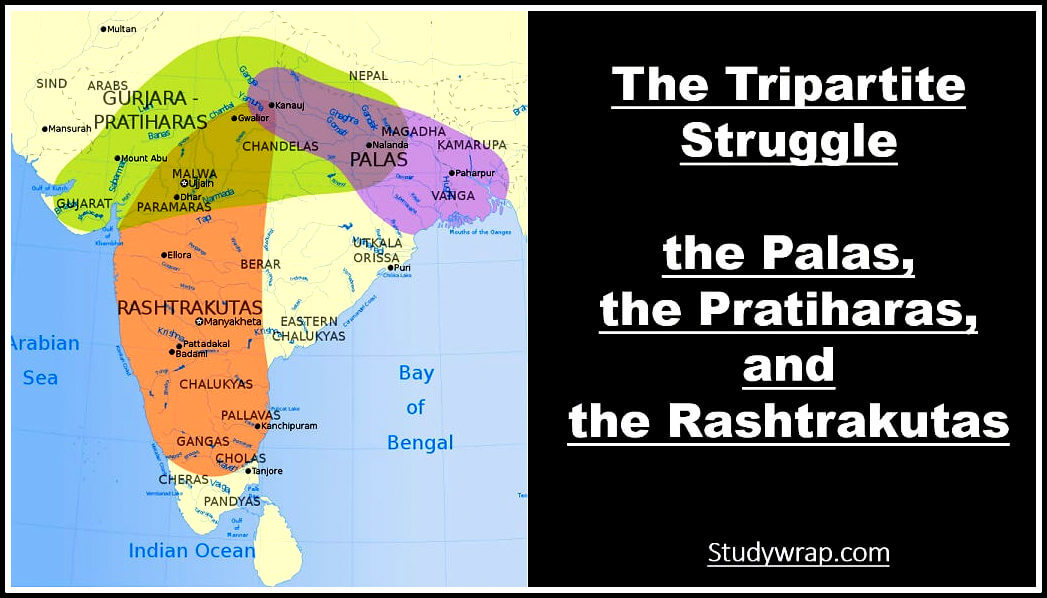History
The Tripartite Struggle – The Palas, Pratihar as and Rashtrakutas
The Tripartite Struggle
(ez-toc)
Introduction
- The Tripartite Struggle took place in the 8th – 9th centuries, between the three great Indian dynasties, the Palas, the Pratiharas, and the Rashtrakutas, for control over the area of northern India, Kannauj.
- Kannauj located in the central Gangetic valley was a very important center for trade and commerce. Hence obviously all the dominant dynasties of the time fought for power and control over this area.
- Palas ruled the eastern parts of India and Pratiharas dominated western India and Rashtrakutas controlled Deccan regions of India.
- This war lasted for two centuries and ultimately ended in favor of the Rajput Pratihara emperor Nagabhata II, who established the city as the capital of the Pratihara state, which ruled for nearly three centuries.
- The tripartite struggle ended in favour of Nagabhata II, Gurjara –Pratihara ruler.
Causes of Tripartite Sruggle
- Kannauj was the erstwhile capital of Harshavardhana Empire in North India.
- The following were the causes which provoked tripartite struggle –
- Kannauj was the symbol of prestige and power during early medieval period.
- Control of Kannauj also implied control of Central Gangetic valley which had plenty of resources and thus it was both strategically and commercial important.
- This center was best for trade and commerce as it was connected to silk route.
- Between the end of the 8th century and the first quarter of the 9th century, three kings ruled over Kannauj namely – Indrayudha, Vijrayudha, and Chakrayudha. These kings were very weak and could be easily defeated.
Desire to loot through war.
Begining of Tripartite Struggle
- The Pratihara ruler named Vatsaraja was very ambitious about Kannauj. Similarly Dharmapala, the Pala ruler also wanted to rule over Kannauj. And thus these two rulers were into a conflict.
- Vatsaraja defeated Dharmapala in a battle at Gangetic Doab. And at the same time Vatsaraja was defeated by the Rashtrakuta king Dhruva. Dhruva also defeated Dharmapala. Finally this pronounced enmity led to Tripartite Struggle between Palas, Rashtrakutas and Pratiharas.
Tripartite Struggle – Phase I
-
-
- The first phase of the tripartite struggle began around 790 AD with a clash between Dharmapala and Vatsaraja.
The battle between Dharmapala and the Pratihara king Vatsaraja at Prayag resulted in the defeat of Dharmapala. - After some time Vatsaraja was defeated by Rashtrakuta king Dhruva.
- Dharmapala took control of Kannauj after Vatsaraja’s fall, but he was again defeated by Dhruva.
- Dhruva, on the other hand, was unable to consolidate his victory because he needed to return to the south to save his own kingdom.
- Rashtrakutas were devastated by a succession struggle after Dhruva’s death in 793 CE.
- By quickly withdrawing from Northern India, the Rashtrakutas not only decimated the Palas’ adversaries, the Pratiharas but also provided the Palas with a good opportunity to add to their might.
- Dharmapala took advantage of the situation and recovered Kannauj, putting Chakrayudha on the throne.
- Dharmapala, via a series of successful expeditions, established himself as the lord of virtually all of Northern India.
- The first phase of the tripartite struggle began around 790 AD with a clash between Dharmapala and Vatsaraja.
-
Tripartite Struggle – Phase II
-
-
- Pratihara ruler Nagabhatta II, the successor of Vatsaraja, invaded Kanauj and expelled its ruler Chakrayudha and established control there.
- As Chakrayudha was Dharmapala’s successor, a battle between Nagabhatta II and Dharmapala was inevitable.
- Nagabhatta II defeated Dharmapala in a battle near Munger.
- After Nagabhata II took possession of Kannauj, the battle for the city intensified.
- His victory was short-lived, as he was soon overthrown by Govinda III (Rashtrakuta king), the successor of Dhruva.
- Govinda III left for the Deccan soon after this victory.
- By the end of the 9th century, the Rastrakutas’ power had begun to wane alongside that of the Palas.
- The Pratiharas emerged victoriously and established themselves as the rulers of central India by the end of the tripartite struggle.
-
Consequences of Tripartite Struggle
- After the attack by Dhruva, Dharmapala could manage to get back control over his territory and placed Chakrayudha on the throne of Kannauj.
- But soon Nagabhata II, the successor of Pratihararuler Vatsaraja conquered Kannauj and drove away Chakrayudha.
- Later Nagabhata II also defeated Dharmapala. The struggle for Kannauj became more severe after the Nagabhata II exercised control over it.
- During the rule of Rashtrakuta ruler Krishna III, there was successful campaign against the Cholas.
- The Rashtrakutas also formed a matrimonial relationship with other feudal kings.
- However, by the end of the 9th Century the power of the Rashtrakutas started to decline along with the Palas.
- And by the end of the tripartite struggle, the Pratiharas emerged victorious and established themselves as the rulers of central India.
So this was all about the The Tripartite Struggle. If you want to read about the other dynasties of Tripartite Struggle, than click on the following links
The Gurjara Pratihara – Rulers, Administration, Art & Architecture
Pala Dynasty – Rulers, Administration, Art & Architecture
The Rashtrakutas Dynasty – Rulers, Administration, Art & Architecture
If you have liked our work, this please share it with your Friends and Family and follow our Facebook Page to get regular updates. Sharing is Caring :-).

